Growing parsley from seed can be a bit frustrating for beginners. But, once you know a few tricks, you’ll have much better success. In this post, I will tell you everything you need to know, and show you exactly how to grow parsley seeds step by step.
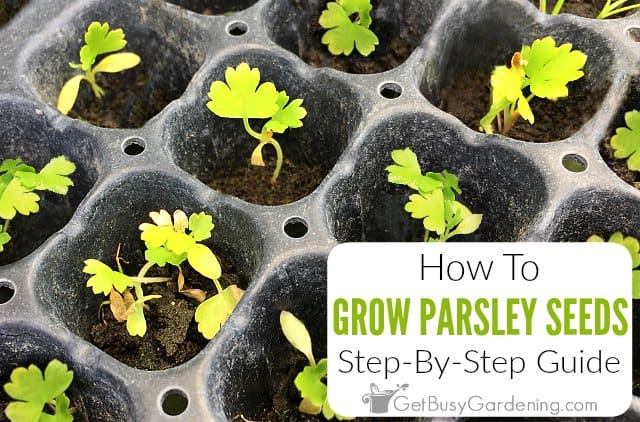
Parsley is a very popular herb that is low maintenance once it becomes established. It is a biennial, which means that it will flower (bolt) the second year.
It’s very hardy too, so most people will be able to have it for two years. It has even survived the winter in my garden here in MN zone 4b before!
This is a complete guide to growing parsley from seed. In it, I will cover everything from start to finish! This includes the best methods to use, and when to start.
I’ll give you step-by-step planting instructions for growing parsley seeds, and the expected germination time so you’ll know exactly what to expect.
Plus you’ll learn about seedling identification, care and transplanting to your garden, how to fix common problems, get answers to your FAQs, and much more!
Growing Parsley From Seed
Growing parsley from seed is pretty easy, but does take some patience (and I’ll probably say that more than once throughout this article!).
But the good news is that you can follow these instructions for any type that you want to grow. The planting steps are the same for all.
Types Of Parsley Seeds To Grow
I grow both flat leaf and curly leaf varieties in my garden every year. Flat leaf parsley is better for cooking. Some of my favorites are Italian dark green flat, single plain-leafed, and large leaf.
Curly leaf parsley is super decorative and fun to grow. Not only is it delicious, it looks beautiful as an ornamental plant in pots or the garden. It makes a wonderful garnish for your dishes too.
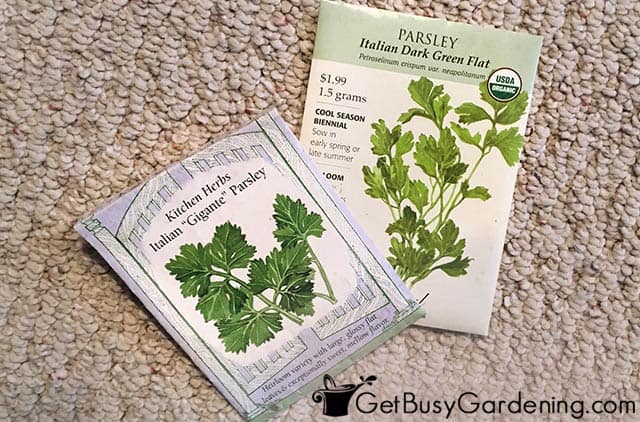
What Do Parsley Seeds Look Like?
Parsley plant seeds are fairly small, and very lightweight. They look a lot like fennel seeds, if you’re familiar with that popular kitchen spice.
They are oval shaped, and slightly rounded into an arch. They are tan in color, and have lines running vertically along them.
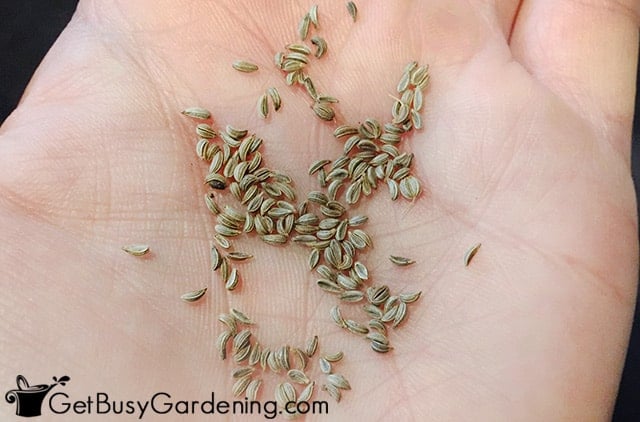
Recommended Parsley Seed Starting Methods
Parsley seeds can either be planted directly into the garden, winter sown, or they can be started indoors. The method you choose will depend on where you live.
If you’re in a cold climate like me, starting parsley seeds indoors will give them more time to mature, which means you’ll get a better harvest. However, I have direct sown them with great success as well.
In warmer growing zones, you should direct sow the seeds right into your garden, or you can try winter sowing them.
Related Post: 3 Seed Starting Methods That Every Gardener Should Try
When To Plant Parsley Seeds
Since it is cold hardy, and won’t be harmed by frost, you can start sowing parsley seeds directly into your garden 4-6 weeks before your average last frost date, or as soon as the soil can be worked in early spring.
If you plan to start them inside, you should be plant them 6-8 weeks before your average last frost date.
The exact planting date will vary depending on where you live. For example, I live in zone 4b, so I would start my parsley seeds indoors sometime in March.
Starting Parsley From Seed
Since they tend to be slow to sprout, there are a few things you can do to ensure good germination, and help to speed things up.
In this section, I’ll talk about how to prepare the seeds, and then show you exactly how to plant them, step by step.
Soaking Parsley Seeds
Before planting parsley seeds, soak them in water for 12-24 hours. Soaking the seeds will help to speed up germination.
It’s not required though, they will germinate just fine without being soaked first. But it’s a good option if you’re in a hurry.
How To Plant Parsley Seeds Step-By-Step
The planting steps are the same whether you’re sowing them indoors or out, you just won’t need any equipment if direct sowing. Otherwise, you’ll need to collect a few items…
Supplies Needed:
- Seedling flat with a lid
- Pre-moistened seed starting soil or peat pellets
- Seeds
- Water
- Heat mat (optional)
Step 1: Fill the seed trays – If you’re starting parsley seeds indoors, fill your seedling trays with a good quality seed starting medium. You could use seed pellets if you prefer, and place those into the tray.
Step 2: Decide how many seeds to plant – Since they can be a bit finicky, it’s a good idea to plant 2-3 per hole, cell, or pellet (whether you’re starting them indoors or outside). If you’re planting the seeds directly into your garden, space the groupings 6-8″ apart.
Step 3: Plant the seeds – Since they’re so small, you should only plant them about 1/4″ deep. To make sowing them easier, I like to lay them on top of the soil, and then gently press them down to the correct depth.
Step 4: Cover the seeds – Cover the seeds lightly with soil, and gently press it down. Don’t pack it down too tight, but just enough so that the soil comes in contact with the seeds.
Step 5: – Add water – Water your seeds with a gentle spray from the hose in your garden, or by pouring water into the trays indoors so you don’t displace the small seeds.
Step 6: – Cover the trays – If you’re growing parsley seeds indoors, then cover each tray with a plastic lid to keep the soil moist, and help it stay warm too.
Related Post: How To Grow Seeds: The Ultimate Seed Starting Guide
Parsley Germination Time
One thing to keep in mind when you’re growing parsley from seed is that they can take a long time to germinate. Normally it’s anywhere from 14-28 days, so be patient.
It’s also normal for germination to be sporadic. So don’t give up if a few of your seeds sprout right away, and the others don’t.
If you’ve started the seeds indoors, using a seedling heat mat can help to speed up germination. Otherwise, be patient and give it plenty of time.
What Does Parsley Look Like When It Sprouts?
The first two leaves that emerge after germination are called the “seed leaves”. They are oval shaped and rounded on the ends.
All of the other leaves that grow after the seed leaves are called the “true leaves”, and those look like tiny baby parsley leaves. Those usually begin to form within a week after the seed leaves unfurl.
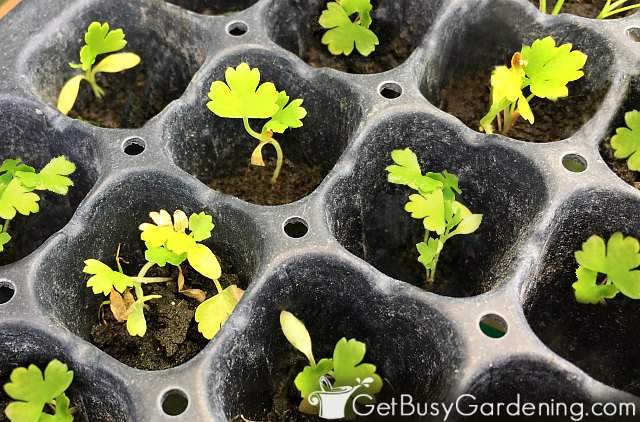
Parsley Seedling Care Tips
In addition to being slow to germinate, the seedings can also be very slow growers. So don’t panic if it seems to take forever for them to get bigger.
Following these parsley seedling care tips will give you the best success, and ensure yours will grow to be healthy and strong. You can also learn more about general seedling care here.
Light
As I already mentioned, parsley seedlings don’t grow very fast. But they will start reaching for the window if they don’t get enough light.
In order to prevent that from happening, it’s best to use a plant light when growing parsley from seed indoors. Hang the light 1-2 inches above the seedlings at all times, and keep it on for 14-16 hours per day.
If you’re a DIYer, then you can make your own lights using an inexpensive fluorescent light fixture and plant grow bulbs.
Whatever you decide to use, make sure to plug your lights into an outlet timer to make it easy to give your seedlings plenty of light.
Related Post: A Beginner’s Guide To Grow Lights For Seedlings
Water
Parsley seedlings like evenly moist soil. So never allow it to dry out completely, but be careful not to overwater them. They won’t tolerate sitting in soggy soil for very long.
To make it easy to water them without harming the delicate seedlings, water from the bottom rather than over the top. Simply pour water into the tray, and dump out any that hasn’t been absorbed after 20 minutes.
Fertilizer
Once parsley seedlings begin growing their first true leaves, it’s time fertilize them. Start with a weak half-dose of liquid fertilizer, then gradually build it up to full strength as your seedlings mature.
Indoors, the best types of liquid fertilizer for seedlings are an organic compost tea solution (you can make your own using compost tea bags), or a plant starter.
You can also use those outdoors, but I prefer to switch to fish emulsion or liquid kelp instead. Those can be a bit stinky, so that’s why I only use those outside.
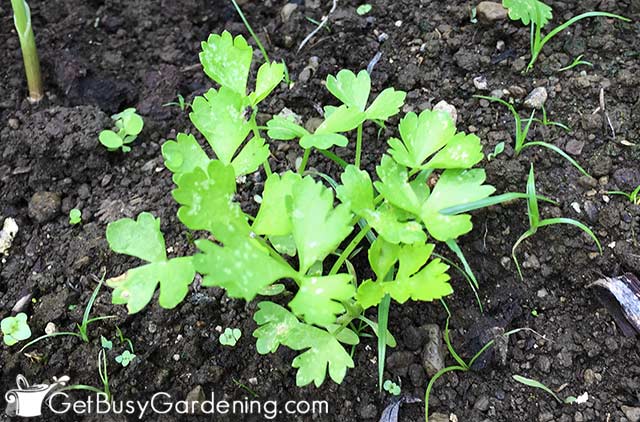
Air Circulation
After your parsley seedlings have a few sets of true leaves, it’s a good idea to start giving them some air circulation. This will help to prevent mold growth, and also strengthens the seedlings.
First, remove the lids to allow them to get some fresh air. Then, after a few days, set an oscillating fan on low, and run it over them for a couple hours a day.
Gradually add more time, until you’re finally able to plug the fan into the same outlet timer as the lights. Just make sure to keep a closer eye on the moisture level. Once the air starts moving, the soil will dry out much faster.
Thinning Parsley Seedlings
If you planted more than one seed per hole, pellet, or cell, then you will need to thin parsley seedlings. Wait until they’re an inch tall, then thin out the weakest one(s) so there’s only one left per grouping.
Don’t pull them out while thinning though, or it could damage the delicate roots of the one you’re keeping. Instead, use a sharp pair of micro-tip snips or bonsai shears to cut them off at the soil level.
Potting Up
If your seedlings grow tall enough indoors to outgrow the cells/pellets, then you can pot them up to give them more room.
Parsley doesn’t love to be transplanted, so I recommend using plantable pots. Not only does that make transplanting into the garden easier, it is less disruptive for the seedlings.
If you like that idea, but prefer a more sustainable alternative to peat, try coco coir or cow pots. They both work great too!
You certainly could use small plastic nursery pots (which are reusable). But be careful not to disturb the roots when transplanting.
Transplanting Parsley Seedlings Into Your Garden
If you are direct sowing them outside, then you can skip this section. But, if you grow parsley from seed indoors, then you’ll definitely want to read through these transplanting tips.
When To Transplant
Since parsley is frost hardy, you can plant the seedlings into the garden as early as 2-4 weeks before your average last frost date. Or you could wait until after frost, if you prefer.
If you’re unsure, you can figure out the exact timing for when to transplant seedlings into your garden here.
Hardening Off
While it’s true they can withstand frost, parsley seedlings growing indoors will still need to be hardened before you can move them outside for good.
This is a critical step that you don’t want to skip, or your seedlings likely won’t survive the shock of being transplanted into your garden.
Starting a few weeks before you plan to transplant, set them outside for a few hours a day in a protected spot. Over the course of the next few weeks, leave them out a little longer every day, gradually introducing them to full sun.
Once they’re used to being outside all day, they’ll be ready to go into the garden. Learn exactly how to harden seedlings before transplanting here.
Where To Plant
Parsley grows great in anywhere from partial shade to full sun. If you live in a warm climate, put it in a spot where it’ll be protected from the hot afternoon sun.
They also do really well in pots and containers, so they would be perfect for growing on your deck or patio.
They do like rich, well draining soil. You can amend garden soil with compost or worm castings. Or use a high quality container potting mix in your pots.
I also like to add organic granular fertilizer into the soil before planting out my parsley starts, which gives them the added nutrients they need to grow nice and full.
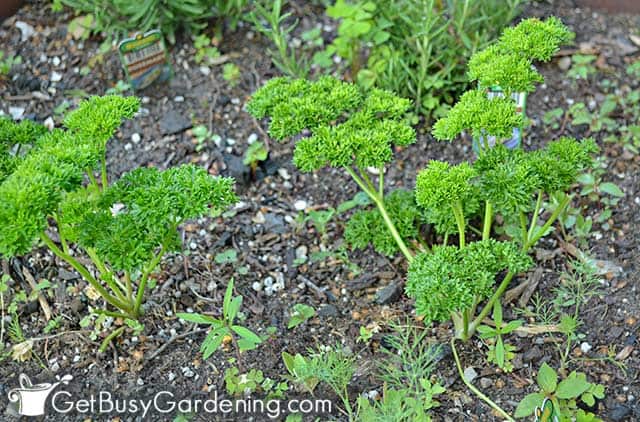
Spacing
Parsley doesn’t need much room to grow, however it will get much bushier if you give it plenty of space. So space your seeds or seedlings about 6-8 inches apart when you plant them into the garden.
Planting Depth
Take care to plant your parsley seedlings into the ground at the same depth they were growing in the pot. You don’t want to plant it too deep, but enough to cover the rootball completely.
How Long From Seed To Harvest?
Parsley days to harvest is usually much earlier than many of the other edibles in your garden, since we eat the leaves. In general, from seed to harvest is somewhere between 70-90 days – but that is the days to full maturity.
You can usually start harvesting parsley sooner than that. Wait until there are at least ten mature leaves on the plant, and then pluck them sparingly until it fills in more.
Related Post: How To Preserve & Store Fresh Parsley
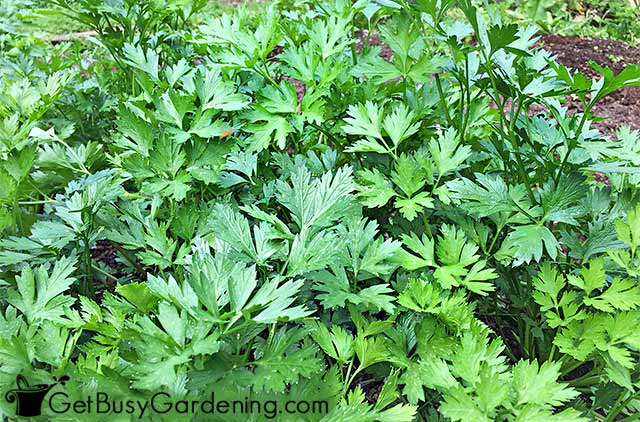
Troubleshooting Common Problems
There’s nothing worse than putting all that time and energy into growing parsley from seed, only to have problems. Especially when you don’t know what’s wrong, or how to fix it!
So below I will list a few of the most common issues you may encounter, and how to fix them. You can read all about fixing common seedling problems here.
Parsley Seeds Not Germinating
When seeds fail to germinate, it can be caused by a few things: old seeds that aren’t viable, soil is too wet or dry, it’s too hot or cold. Make sure the soil temperature is between 50-85F (using a soil thermometer), and it’s not soggy or dried out. Also remember that they are notoriously slow, so you may just need to give it more time.
Tall, Leggy Seedlings
If your parsley seedlings are growing tall and leggy indoors, or look like they’re reaching for the window, that means they aren’t getting enough light. So, if you start to see this happening, then add a grow light right away.
Seedlings Are Not Growing
First, remember that parsley seedlings are naturally slow growers, so this is pretty normal. Just make sure the soil stays consistently moist, and start feeding them once they get a few true leaves to help them grow their best.
Parsley Seedlings Falling Over
If your seedlings flop over and the base and die, this is called damping off, and it’s caused by using dirty equipment. Unfortunately, there’s nothing you can do to save the ones that have already toppled over. All you can do is make sure you properly clean and disinfect the flats before using them again.
FAQs About Growing Parsley Seeds
In this section, I will answer some of the most frequently asked questions about growing parsley from seed. If you have a question that wasn’t answered here, then ask it in the comments section below.
Does parsley need light to germinate?
No, parsley seeds do not need light to germinate. Just make sure you don’t plant them too deep.
How deep do you plant parsley seeds?
The rule of thumb for seed planting depth is twice as deep as the seed is wide. So, since they are fairly small, plant parsley seeds about 1/4″ deep.
How many parsley seeds should I plant per hole/cell?
Because they can be a little stubborn, it’s a good idea to plant 2-3 parsley seeds per hole or cell, and then thin out the extras. But if you’re using brand new seeds, you can keep it to one per hole.
How long does parsley take to germinate?
Germinating parsley seeds can take anywhere from 14 – 28 days in ideal conditions. It’s also very common for germination to be sporadic.
How do you germinate parsley seeds faster?
Soaking the seeds before planting, and also placing the trays on a heat mat will both help make parsley seeds germinate quicker.
Growing parsley from seed can be a bit of a challenge, so remember to have patience, and give them plenty of time. Starting them indoors will give them more time to mature, but you may find it’s easier to direct sow them instead. Whichever sowing method you choose, following the parsley planting instructions above will give you the best results.
Up Next, learn all about how to care for your parsley plants here!
If you need more help, and would like to learn how to grow any type of garden seed you want, check out my online Seed Starting Course. This comprehensive, self-paced online course is specifically designed to teach beginners how to grow seeds. Sign up and get started right now!
Otherwise, if you’re just looking for a quick-start guide or refresher to help get you going, then you need a copy of my Starting Seeds Indoors eBook!
More Posts About Growing Seeds
- How To Grow Basil From Seed
- How To Grow Lavender From Seed & When To Plant
- How To Plant & Grow Carrots From Seed
- How To Grow Broccoli From Seed: Step-By-Step
Share your tips for growing parsley from seed in the comments below!
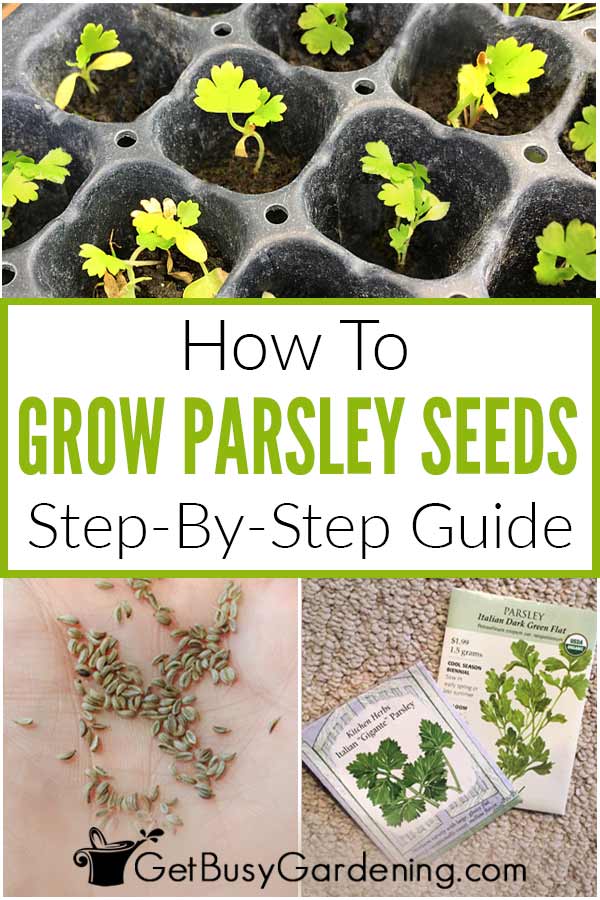
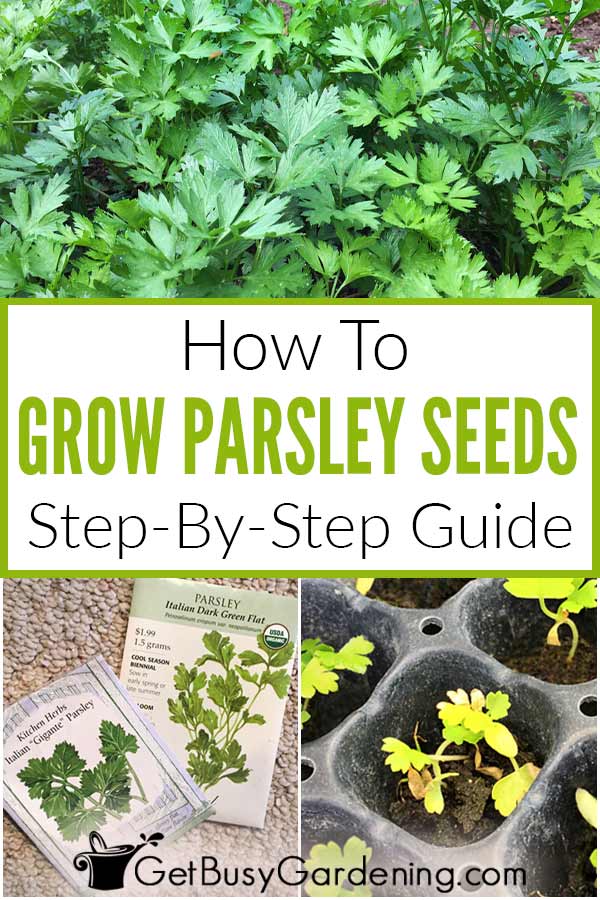
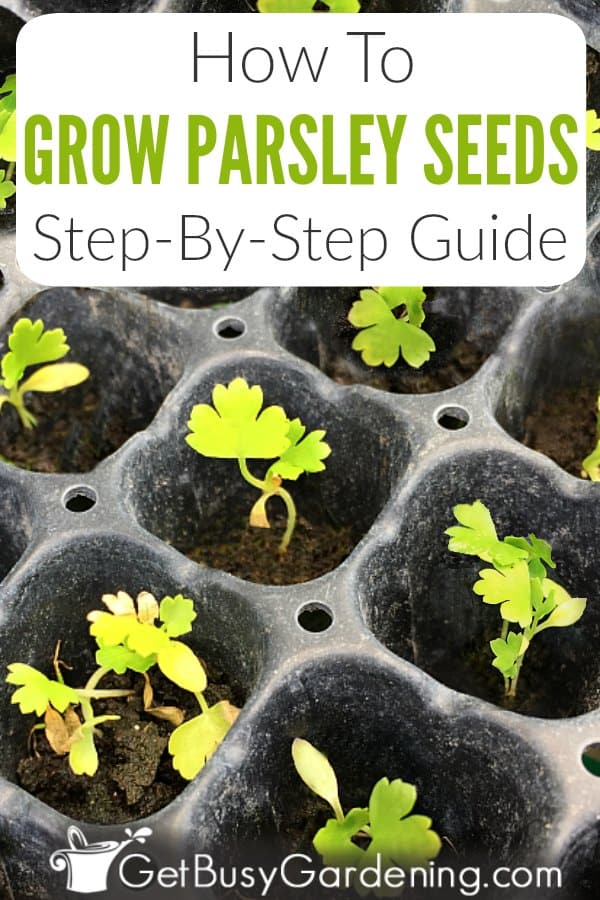

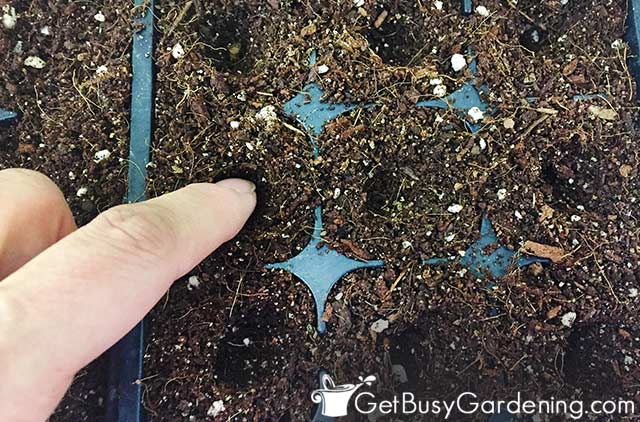


Nan says
It’s May. I live on the coast of SC. My last year’s parsley is blooming. It’s in a pot. Can I just let it go to seed and let those seeds fall to the ground?
Will I get more plants. If not I guess I need to buy a new plant since I understand the leaves aren’t as good after the bloom. Appreciate your help.
Amy Andrychowicz says
They aren’t very aggressive reseeders, so you’ll probably have to give them some help. I would collect the seeds, then plant them into the ground myself, rather than rely on them to sow themselves. Parsley is a bit finicky to start from seeds, and it takes some time. So, if you’re patient, then you could definitely go this route.
Sanele South Africa says
I did try planting parsley from seeds and they do come out late when am about to give up, I will try again one more time, I was planning to put maybe 10 seeds in one hole:) cos when I planted them the stems look small and they just fall when u water them.
Lianne says
Hi Amy. I’ve planted my parsley in a seed tray and they’ve all germinated!
Now I’m potting in can I plant a few stems in each pot or is it best to plant only ONE stem per pot?
Thank you.
Your article was really useful and I can see where I’ve gone wrong already!!
Amy Andrychowicz says
Woohoo, congrats! I recommend planting only one parsley seedling per pot. LOL, glad to hear you found the article helpful! 🙂
Fernando L Benitez says
How about seeding coriander ( Cilantrillo )seeds?
Fernando
Puerto Rico
Amy Andrychowicz says
Sow them directly into your garden in the fall/winter. This post will give you more details… How To Grow Cilantro (Coriander)
Mayavata says
14 to 28 days ?!? No wonder I thought the seeds were no good. Tragically, I have the patience of a 5 year old. If I don’t get germination in a week to 10 days, I assume either the seeds are too old or I’ve screwed something up. Thanks for the heads up.
LOL…I’m finding out a lot of things I’m trying to germinate take longer than my limited patience has allowed for. I’m very grateful for the internet and websites like yours.
Amy Andrychowicz says
LOL! You’re welcome. Yes, parsley seeds are slow to germinate, and can be very finicky. So you do need to have some patience when growing them. If you don’t want to wait, then try some of these instead… 17 Easiest Seeds To Start Indoors.
Karen says
You did a great job of hitting all the needed steps and issues with growing parsley from seed. This will be my only second year of starting parsley inside and I wanted to make sure that I was ready. I am going to plant extra for my black swallowtail friends. I am thrilled to find you…we northern gardeners need special information. thanks.
Amy Andrychowicz says
Wonderful, so glad you found my parsley seed growing tips helpful! Hope all of your seeds will grow great for you! Good for you to plant extra for the swallowtails! Love it! And yes, us northern gardeners need extra support. 🙂
Brian says
Parsley are the first seeds I ever germinated, very cool to repeat.
Amy Andrychowicz says
Woohoo, congratulations!
Adrienne Audrey Carrie says
I love parsley for cooking. I will have to grow my own seeds this year
Amy Andrychowicz says
For sure! It’s so nice to have fresh parsley whenever you need it. 🙂